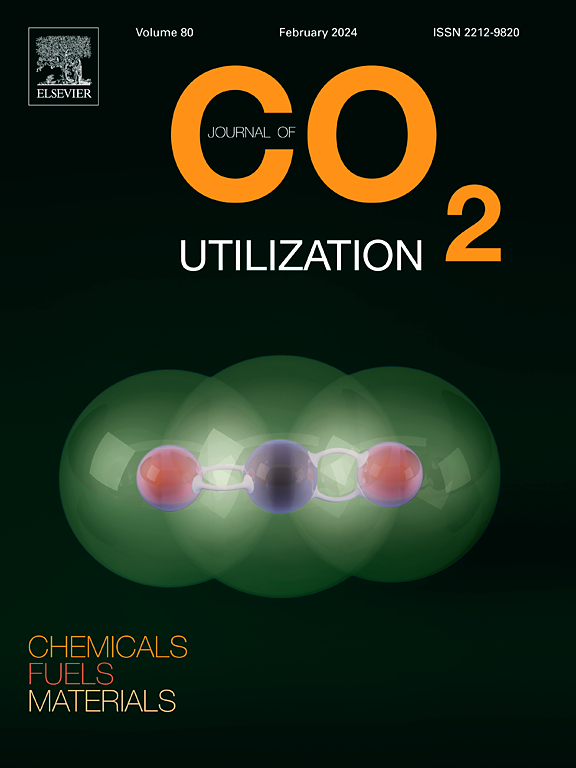Electrochemical investigation of the influence of gas compositions on industrial-sized fuel electrode supported single cells under co- and CO2-electrolysis conditions
IF 8.4
2区 工程技术
Q1 CHEMISTRY, MULTIDISCIPLINARY
引用次数: 0
Abstract
Solid oxide electrolysis cells (SOECs) offer high efficiency for Power-to-X applications, but their performance under varying gas compositions—especially in co- and CO2-electrolysis—requires further clarification. This study addresses this challenge by investigating the electrochemical behavior of fuel-electrode-supported, industrial-sized planar SOECs (81 cm active area) during steam, co-, and CO2-electrolysis at 800 °C. Two SOECs were examined using polarization curves, electrochemical impedance spectroscopy (EIS) with total harmonic distortion, and Distribution of Relaxation Times (DRT), complemented by temperature and gas composition analysis. In addition, a cell was analyzed with Scanning Electron Microscopy (SEM) prior to experiments to provide supporting structural information on the cell. This comprehensive approach enabled detailed insight into reaction mechanisms, resistive losses, and electrode processes under different gas atmospheres. Co-electrolysis experiments were conducted with varying H2O/CO2 ratios, using either CO or H2 in the gas mixture to isolate their individual effects. In CO2-electrolysis, cells were tested with CO2/CO ratios of 80/20 and 100/0. Transitions between steam-, co-, and CO2-electrolysis modes were also studied. The results show that gas composition—particularly the partial pressures of H2O, CO2, H2, and CO—significantly affects cell performance. Lower H2O/CO2 ratios increased area-specific resistance (ASR) and led to more endothermic operation. The presence of H2 maintained ASR near steam electrolysis levels, while CO increased it towards CO2-electrolysis values. DRT analysis revealed additional peaks related to CO2/CO processes. CO2-electrolysis exhibited the highest ASR, indicating greater resistive losses. These findings enhance understanding of SOEC operation under realistic conditions and support their optimization for industrial use.

co-和co2 -电解条件下气体成分对工业尺寸燃料电极负载的单体电池影响的电化学研究
固体氧化物电解电池(soec)为Power-to-X应用提供了高效率,但其在不同气体成分下的性能(特别是co-和co2 -电解)需要进一步澄清。本研究通过研究燃料电极支撑的工业尺寸平面soec(81平方厘米的有效面积)在800°C下蒸汽、co和co2电解过程中的电化学行为,解决了这一挑战。利用极化曲线、电化学阻抗谱(EIS)和弛豫时间分布(DRT)以及温度和气体成分分析对两种soec进行了检测。此外,在实验之前,用扫描电子显微镜(SEM)分析细胞,以提供细胞的支持结构信息。这种全面的方法可以详细了解不同气体气氛下的反应机制、电阻损耗和电极过程。在不同的H2O/CO2比例下进行共电解实验,在混合气体中使用CO或H2来分离其各自的影响。在二氧化碳电解中,用80/20和100/0的CO2/CO比率对电池进行测试。还研究了蒸汽电解、co电解和co2电解模式之间的转换。结果表明,气体组成,特别是H2O、CO2、H2和co的分压对电池性能有显著影响。较低的水/二氧化碳比增加了面积比电阻(ASR),并导致更多的吸热操作。H2的存在使ASR维持在蒸汽电解水平附近,而CO的存在使ASR向co2电解值升高。DRT分析显示了与CO2/CO过程相关的附加峰。co2电解表现出最高的ASR,表明更大的电阻损失。这些发现增强了对SOEC在现实条件下运行的理解,并支持其在工业应用中的优化。
本文章由计算机程序翻译,如有差异,请以英文原文为准。
求助全文
约1分钟内获得全文
求助全文
来源期刊

Journal of CO2 Utilization
CHEMISTRY, MULTIDISCIPLINARY-ENGINEERING, CHEMICAL
CiteScore
13.90
自引率
10.40%
发文量
406
审稿时长
2.8 months
期刊介绍:
The Journal of CO2 Utilization offers a single, multi-disciplinary, scholarly platform for the exchange of novel research in the field of CO2 re-use for scientists and engineers in chemicals, fuels and materials.
The emphasis is on the dissemination of leading-edge research from basic science to the development of new processes, technologies and applications.
The Journal of CO2 Utilization publishes original peer-reviewed research papers, reviews, and short communications, including experimental and theoretical work, and analytical models and simulations.
 求助内容:
求助内容: 应助结果提醒方式:
应助结果提醒方式:


